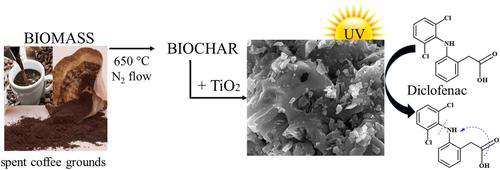当前位置:
X-MOL 学术
›
Appl. Organomet. Chem.
›
论文详情
Our official English website, www.x-mol.net, welcomes your feedback! (Note: you will need to create a separate account there.)
Conversion of spent coffee grounds to biochar as promising TiO2 support for effective degradation of diclofenac in water
Applied Organometallic Chemistry ( IF 3.9 ) Pub Date : 2020-09-21 , DOI: 10.1002/aoc.6001 Joseane Sarmento Lazarotto 1 , Vitória Lima Brombilla 1 , Siara Silvestri 2 , Edson Luiz Foletto 1, 2
Applied Organometallic Chemistry ( IF 3.9 ) Pub Date : 2020-09-21 , DOI: 10.1002/aoc.6001 Joseane Sarmento Lazarotto 1 , Vitória Lima Brombilla 1 , Siara Silvestri 2 , Edson Luiz Foletto 1, 2
Affiliation

|
A novel composite, biochar derived from spent coffee grounds with immobilized TiO2 (biochar–TiO2) was prepared, characterized, and applied as an alternative, effective, and sustainable photocatalyst for degrading diclofenac from aqueous solution. Composites with different mass ratios between TiO2 and biochar were prepared by mechanical mixing and subsequent pyrolysis in an inert atmosphere of N2 at 650°C. The sample with biochar–TiO2 ratio of 1:1 presented a degradation efficiency of 90% at just 120 min versus 40% for TiO2 used as reference. This fact is associated with a set of intrinsic characteristics obtained during the formation of the composite, such as superior pore size, avoiding the recombination of the ē/h+ pair, bandgap reduction, and promotion of reactive oxygen species due to phenolic groups present on the biochar surface. The dominant reactive species involved during the photocatalytic degradation of diclofenac were h+ and •OH. The diclofenac degradation pathways were determined based on the identification of intermediates and nonpurgeable organic carbon (NPOC) analysis. The novel biochar–TiO2 composite prepared in this work showed high physical–chemical stability and efficiency over five consecutive cycles of reuse, proving to be a highly promising photocatalyst for degrading diclofenac in water.
中文翻译:

将用过的咖啡渣转化为生物炭是有希望的TiO2载体,可有效降解水中的双氯芬酸
制备,表征和表征了一种新颖的复合材料,其由废咖啡渣中固定化的TiO 2(biochar–TiO 2)衍生而来,并被用作替代,有效且可持续的光催化剂,用于从水溶液中降解双氯芬酸。通过机械混合并随后在N 2的惰性气氛中于650°C下进行热解,制备了TiO 2与生物炭之间质量比不同的复合材料。生物炭-TiO 2比例为1:1的样品在120分钟内的降解效率为90%,而TiO 2为40%用作参考。这一事实与在复合材料形成过程中获得的一组固有特性有关,例如优异的孔径,避免了ē / h +对的重组,带隙减少以及由于存在于基团上的酚基团而促进了活性氧的产生。生物炭表面。双氯芬酸的光催化降解过程中涉及的主要反应物种为h +和• OH。基于中间体的鉴定和不可净化的有机碳(NPOC)分析,确定了双氯芬酸的降解途径。新型生物炭–TiO 2 这项工作中制备的复合材料在五个连续的重复使用周期中显示出很高的物理化学稳定性和效率,被证明是降解水中双氯芬酸的极有希望的光催化剂。
更新日期:2020-11-06
中文翻译:

将用过的咖啡渣转化为生物炭是有希望的TiO2载体,可有效降解水中的双氯芬酸
制备,表征和表征了一种新颖的复合材料,其由废咖啡渣中固定化的TiO 2(biochar–TiO 2)衍生而来,并被用作替代,有效且可持续的光催化剂,用于从水溶液中降解双氯芬酸。通过机械混合并随后在N 2的惰性气氛中于650°C下进行热解,制备了TiO 2与生物炭之间质量比不同的复合材料。生物炭-TiO 2比例为1:1的样品在120分钟内的降解效率为90%,而TiO 2为40%用作参考。这一事实与在复合材料形成过程中获得的一组固有特性有关,例如优异的孔径,避免了ē / h +对的重组,带隙减少以及由于存在于基团上的酚基团而促进了活性氧的产生。生物炭表面。双氯芬酸的光催化降解过程中涉及的主要反应物种为h +和• OH。基于中间体的鉴定和不可净化的有机碳(NPOC)分析,确定了双氯芬酸的降解途径。新型生物炭–TiO 2 这项工作中制备的复合材料在五个连续的重复使用周期中显示出很高的物理化学稳定性和效率,被证明是降解水中双氯芬酸的极有希望的光催化剂。


























 京公网安备 11010802027423号
京公网安备 11010802027423号